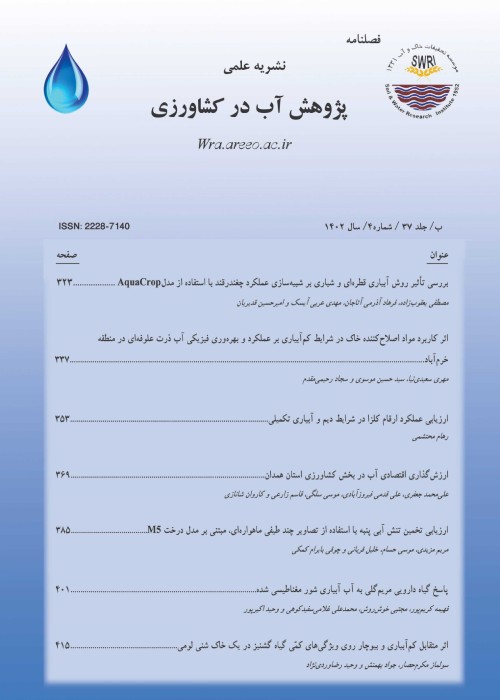Simulation of Full Shape of Wetting Bulb in Subsurface Drip Irrigation System with Nonlinear Regression Model
Author(s):
Article Type:
Research/Original Article (دارای رتبه معتبر)
Abstract:
The wetted profile pattern is an important factor to consider when designing and managing a surface and subsurface drip irrigation systems. The knowledge of the pattern dimensions is imperative in choosing the suitable spacing between emitters and the correct distance between laterals. The experiments were carried out in a transparent plexiglass tank (0.5 *1.22 *3 m) using three different soil textures (sandy clay, sand clay loam, and sandy loam). The drippers were installed at 3 different soil depths (15, 30 and 45 cm). The emitter outflows were 2.4, 4 and 6 Lhr-1 with irrigation duration of 6 hr. In this study, using the data obtained from the laboratory experiments and conducting the nonlinear regression analysis using Microsoft Excel Solver tool 2010, an empirical model was developed to predict the horizontal distribution of the wetting front for different application times. The suggested model includes estimation of the wetted radius at the top and bottom of the emitter horizontal axis as a function of emitter discharge, saturated hydraulic conductivity, water application time, soil bulk density, emitter installation depth, initial soil moisture content, and the percentages of sand, silt, and clay in the soil. We pursued a similar procedure in developing empirical formulas for estimating the wetted radius at different soil depths (by optimizing the coefficients of Equations) to predict the full shape of the wetting pattern. The best performance of the model was related to the depth of zero (on the emitter positioning axis), where the values of RMSE, MAE, and R2 were 2.15, 1.7 cm, 14.85 % and 0.92, respectively. The lowest performance of the model was related to the depth of 20 cm from the emitter, where values of RMSE, MAE, and R2 were 3.93, 3.26 cm, 37.55% and 0.75, respectively (R2 coefficient was significant at 5% level). The results of this research showed that the suggested model predicted the full shape of wetting pattern with acceptable accuracy. Considering these models in designing subsurface drip irrigation systems could improve system performance.
Keywords:
Language:
Persian
Published:
Journal of Water Research in Agriculture, Volume:33 Issue: 2, 2019
Pages:
327 to 338
magiran.com/p2022773
دانلود و مطالعه متن این مقاله با یکی از روشهای زیر امکان پذیر است:
اشتراک شخصی
با عضویت و پرداخت آنلاین حق اشتراک یکساله به مبلغ 1,390,000ريال میتوانید 70 عنوان مطلب دانلود کنید!
اشتراک سازمانی
به کتابخانه دانشگاه یا محل کار خود پیشنهاد کنید تا اشتراک سازمانی این پایگاه را برای دسترسی نامحدود همه کاربران به متن مطالب تهیه نمایند!
توجه!
- حق عضویت دریافتی صرف حمایت از نشریات عضو و نگهداری، تکمیل و توسعه مگیران میشود.
- پرداخت حق اشتراک و دانلود مقالات اجازه بازنشر آن در سایر رسانههای چاپی و دیجیتال را به کاربر نمیدهد.
In order to view content subscription is required
Personal subscription
Subscribe magiran.com for 70 € euros via PayPal and download 70 articles during a year.
Organization subscription
Please contact us to subscribe your university or library for unlimited access!


